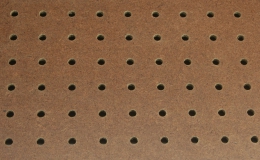
Fiberboard (cellulosic fiber) is a fibrous-felted, homogeneous panel made from ligno-cellulosic fibers (usually wood) which has a density of less than 31 lb/ft3 (497 kg/m3), but more than 10 lb/ft3 (160 kg/m3). Fiberboard is characterized by an integral bond which is produced by interfelting the fibers, but which has not been consolidated under heat and pressure as a separate stage in manufacture. Other materials may be added to fiberboard during manufacture to improve certain properties.
Types of fiberboard (in order of increasing density) include particleboard, medium-density fiberboard, and hardboard. Fiberboard is sometimes used as a synonym for particleboard, but particleboard usually refers to low-density fiberboard. Plywood is not a type of fiberboard, as it is made of thin sheets of wood, not wood fibers or particles. Fiberboard, particularly medium-density fiberboard (MDF), is heavily used in the furniture industry. For pieces that will be visible, a wood veneer is often glued onto fiberboard to give it the appearance of conventional wood.
Fiberboard, classified by ASTM C208, Standard Specification for Cellulosic Fiber Insulating Board, has many benefits and is used in residential and commercial construction. Uses and applications of fiberboard include:
Fiberboard is also used in the auto industry to create free-form shapes such as dashboards, rear parcel shelves, and inner door shells. These pieces are usually covered with a skin, foil, or fabric such as cloth, suede, leather, or polyvinyl chloride.
Urea-formaldehyde (UF) resins are usually used in the medium density fiberboard (MDF) industry because of their low cost and fast curing characteristics. However, pressures on the use of UF resins are mounting steadily due to potential problems associated with formaldehyde emission. On the other hand, phenol-formaldehyde (PF) resins are more durable and do not emit formaldehyde after cure. But the Industry has traditionally shied away from using PF resins due primarily to their higher cost and much slower curing rate than UF resins. However, the press times for PF-bonded fiberboard can be substantially reduced by manipulating the fiber mat temperatures, molecular weight distribution of PF resins and pressing parameters. As a result, the press times for PF-bonded fiberboard can be made comparable to those for UF-bonded fiberboard. Also, the resin content required for PF-bonded fiberboard is less than 5% to achieve a good board quickly. This is considerably lower than that required for UF-bonded fiberboard.
Certain types of fiberboard can be considered "green". Consisting of bio-based, secondary raw materials (wood chip or sugarcane fibers) recovered from within 100 miles (160 km) of manufacturing facilities, the binding agent used in this type of fiberboard is an all-natural product, consisting of vegetable starch containing no added formaldehydes.
Fiberboard is frequently reused as a component of many consumer products, such as countertops and furniture. The only limitation on reuse is moisture, as fiberboard is often highly absorbent and can be damaged if left out in the rain, or uncovered prior to resale. Additional options include recycling and waste to energy.
Reuse, Recycling, Waste to Energy
msf – thousand square feet
North American Fiberboard Association
You have no items in your list.
Click or tap on the My List stars on any business card or profile to add or remove organizations.